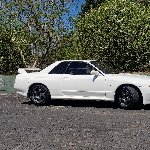R32 Gtr Single Gt35r. Apexi's De-jetro A Good Choice?
Announcements
-
Similar Content
-
Latest Posts
-
Yes, well, the problem being the plastic tank. The RWD R32s obviously have a similar tank, but in steel, viz and you can see a nice sheetmetal swirl pot baffle. I would imagine that that is somewhat harder to do on a plastic tank.
-
By soviet_merlin · Posted
Okay, good to know that it is not the same kit. There is no baffling in the tank from factory either, no? Possibly Nissan worked against that by feeding the fuel return line back into that little shoe the fuel pump sits in. From what I remember the FPG video mentioned that can actually be problematic if done with a high flow pump. Because the fuel is returned with more pressure through that little spout. There are so many ways to overthink this. It does my head in. I'll see what Unigroup says as well and go from there. It's a shame that the difference between the simple hanger and surge tank setup is ~$700. Add the new lift pump purchase on top and it becomes a bit hard to justify for a car that doesn't see that much action. First world problems I guess. -
Looks like they've been through a few versions of the kit; that is not the one I had trouble with (it had the level sender attached to baffles on the floor, the one you linked the level sender is hung from the hat). One obvious point about that kit is it has no baffles at all, not even the factory setup (although it looks like you can retain the factory setup if you want). Not sure if that will be an issue or not, the good news is it looks like you can get the pump nice and low in the tank, but that doesn't help if the fuel is all sloshing to one side of a wide flat tank
-
By soviet_merlin · Posted
One more question if you don't mind. Is the first kit you tried the same one as they currently sell as their fuel-pump-hanger kit? https://frenchysperformancegarage.com/collections/fuel-system-kits/products/fpg-bnr32-fuel-pump-hanger-kit-single-fits-stagea-c34-nissan-skyline-gt-r-r32-fpg-087?variant=42131478315186 Because according to their video the low fuel warning thing can be taken from the OEM hanger and attached to their new hanger. Just wondering whether this is the kit you weren't happy with, or whether it's a different revision. Thanks again!
-






Recommended Posts
Create an account or sign in to comment
You need to be a member in order to leave a comment
Create an account
Sign up for a new account in our community. It's easy!
Register a new accountSign in
Already have an account? Sign in here.
Sign In Now